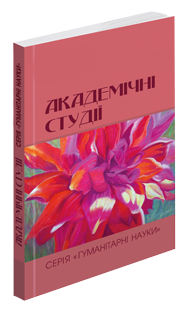Abstract
The article analyzes Ostap Vyshnya’s “Hunting Smiles” from the standpoint of ecocriticism. In this series of short humorous stories, the author reveals with humour and irony deep issues of human interaction with the natural environment, depicting scenes of hunting adventures, descriptions of nature and the accompanying hunting traditions. Behind the superficial lightness and humorous form are hidden deep reflections on man, his interaction with nature, as well as on social realities and personal freedom in the conditions of Soviet reality. Smiles are distinguished by subtle humour, irony and picturesqueness of images that recreate the nature of Ukraine and the character of its people. The writer’s humour reveals a hidden protest against the destruction of national identity and restrictions on freedom of speech, which made his works an important element of cultural resistance to the totalitarian system. The collection outlines the features of the formation of readers’ ecological consciousness and examines the relationship between human activity (hunting, fishing) and the ecological system, where nature appears as self-sufficient, self-valuable and requires careful treatment. In «Hunting Smiles», Ostap Vyshnya affirms nature-centric ecological consciousness, emphasizing that nature is the most excellent value for humanity, so people should take care of harmonious coexistence with it and maintain ecological balance. The ecocentricity of the author’s worldview manifests in the reproduction of positive images of nature and negative images of poachers, creating appropriate narrative strategies aimed at love for nature and harmonising human and environmental relations. Animals in the works appear not simply as prey but as symbols of natural balance and harmony, calling for respect and responsibility. The writer condemns the actions of poachers and their detrimental impact on the environment. Through comic situations and exaggeration, the author draws attention to the serious consequences of a thoughtless attitude towards nature, actualizing the issue of human responsibility towards it. It is emphasised that the work of Ostap Vyshnya is of great importance in forming the ecological consciousness of readers and promoting cultural awareness of the need for harmonious coexistence with nature.
References
Білоус Г. «Подай свій хліб – і я скажу, хто ти…»: до 110-річчя від дня народження Остапа Вишні. Вітчизна. 1999. № 11-12. С. 131–140.
Вертипорох О. Екокритика як модель інтерпретації сучасного художнього тексту (на матеріалі романістики Євгена Пашковського). Актуальні питання гуманітарних наук. Мовознавство. Літературознавство. 2021. № 36. Том 1. С. 122–127.
Вишня О. Мисливські усмішки. Харків: Фоліо, 2013. 189 с.
Гальченко В. «Десятирічка» Остапа Вишні: рукопис із шухляди часів незалежності. Слово і час. 2007. № 8. С. 57–69.
Гальченко С. Історія тексту. Джерелознавчі і текстологічні аспекти творчості П. Г. Тичини, В. М. Сосюри та Остапа Вишні. К.: Наук. думка, 2014. 687 с.
Горболіс Л. Екокритичні виміри української літератури: доцільність і прийнятність застосування (на прикладі «Лісової пісні» Лесі Українки). Філологічні трактати. 2011. Т. 3. № 3. С. 5–10.
Горболіс Л. Екологічна культура героїв у художньому потрактуванні українських письменників. Суми: Сум ДПУ ім. А. С. Макаренка, 2010. 132 с.
Гриценко О. Остап Вишня в українській культурі пам’яті: «Король тиражів», «народний гуморист», суспільна інституція, знаряддя пропаганди, «національний мученик». Київ, 2019. 390 с.
Зуб І. Остап Вишня: Нарис життя і творчості. К.: Дніпро, 1989. 239 с.
Клочек Г. Природа в творах Лiни Костенко // Костенко Л. Бiографiя. Вибранi поезiї. «Маруся Чурай». Кiровоград: Степова Еллада, 1999. С. 5–23.
Косяченко В. «Письменники так, спроста не бувають…». Про Остапа Вишню. Слово і час. 1993. № 7. С. 19–24.
Мовчан Ф. Король українського тиражу 20-х років ХХ століття (Остап Вишня). Українська мова та література. 1997. № 25–28. С. 18–22.
Олешко А. Екокритицизм як напрямок літературних досліджень. Матеріали науково-практичної конференції «Новини передової науки» (м. Софія, 15–22 травня, 2016 р.). Софія : Бял ГРАД-БГ, 2016.
Про Остапа Вишню: Спогади / Упоряд. В.Губенко-Маслюченко, А.Журавський. Київ: Радянський письменник, 1989. 334 с.
Сухенко І. Екокритичні орієнтири на сучасному етапі літературознавчих досліджень: проблема визначення. Актуальні проблеми та перспективи дослідження літератури зарубіжних країн. 2011. С. 259–266.
Ткачук М. Людина і природа в українській літературі крізь призму екокритики. Дивослово. 2011. № 6. С. 52–56.
Цеков Ю. Остап Вишня – відомий і невідомий (До 100-річчя з дня народження письменника). Українська мова і література в школі. 1989. № 11. С. 3-10.
Шедловська М. Означення та типи екологічної свідомості. Український соціум. 2011. № 2. С. 95–100.

